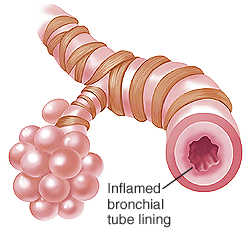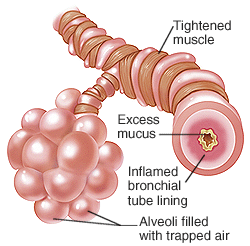How Your Lungs Work
How Your Lungs Work
When you breathe, you take air in through your nose or mouth. The air goes down the throat and trachea (windpipe). It then goes into the lungs. The lungs have branching airways called bronchial tubes. These airways are wrapped by bands of muscle. The lining of the airways makes a sticky substance called mucus. This mucus helps you get rid of things you breathe in that may irritate your lungs.
The airways (bronchial tubes) become smaller the deeper they are in the lungs. The smallest airways are called bronchioles. The bronchioles end in balloonlike sacs called alveoli. These sacs take oxygen from the air you breathe and pass it into the bloodstream. They also collect carbon dioxide from the bloodstream for you to breathe out.
When You Have Asthma
When you have asthma, triggers can inflame the sensitive airways in your lungs. This inflammation makes the airways "twitchy" (even more sensitive to triggers). Your airways can then become so narrow that air has trouble getting in and out of your lungs. This is what causes the symptoms of an asthma flare-up.
Inflamed Airways
When triggers irritate your lungs, the lining of the airways becomes inflamed and swollen. This makes the airways slightly narrower. But air can still move through the airways and in and out of the alveoli. You may have no symptoms. Or, you may have mild symptoms such as a cough, chest tightness, shortness of breath, or a lack of energy.
Flare-Ups
When already-inflamed airways react to a trigger, their lining swells up even more and makes extra mucus. This mucus may plug up the airways. The muscles around the airways tighten (bronchospasm), making the airways even narrower. Air then has a hard time moving through the airways and in and out of the alveoli. You may wheeze, cough a lot, or have trouble breathing.
Updated:
March 21, 2017
Reviewed By:
Chris O'BrienChris O'Brien RN MPH,Lesperance, Leann MD


